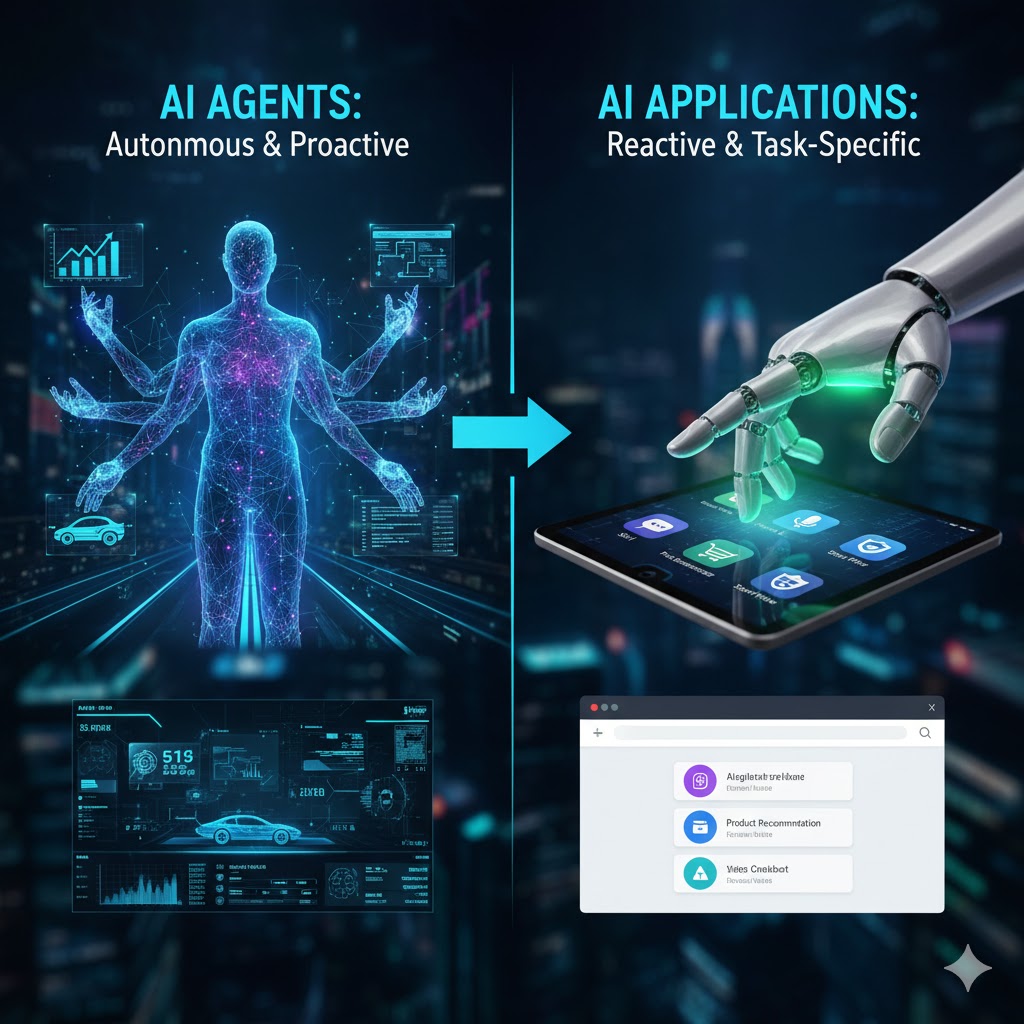AI Agents vs. AI Applications: The Key Differences in Autonomy & Scope
The main distinction between AI agents and AI applications lies in their level of autonomy and the scope of their actions.
🤖 AI Applications: The Smart Tool
An AI Application is a software program that uses Artificial Intelligence to perform a specific, single task when a human asks it to.
- ⚡ Role: They are reactive tools (they wait for your command).
- 🎯 Scope: They focus on one job, like generating text, recognizing a face, or making a prediction.
- 💡 Example: A spam filter 🗑️ that decides if an email is junk. A chatbot 💬 that answers common FAQs. A photo app 🖼️ that sorts images by subject.
In simple terms, an AI Application is a specialized tool you use.
🚀 AI Agents: The Autonomous Worker
An AI Agent is a more advanced system that has a long-term goal and can autonomously plan, use multiple tools, and execute a multi-step workflow to achieve that goal.
- 🧠 Role: They are proactive workers (they take initiative).
- 🛠️ Scope: They manage complex projects that require reasoning, memory, and interacting with the real world (via APIs).
- 🗺️ Example: An Automated Travel Planner ✈️ that researches flight prices, checks hotel availability, books the best option, and sends you the confirmation—all based on a single initial goal.
In simple terms, an AI Agent is an autonomous worker you delegate a goal to.

1. AI Agents (Autonomous, Proactive)2
An AI Agent is a system designed to perceive its environment, make independent decisions, and execute multi-step actions to achieve a high-level goal with minimal human intervention.3
| Feature | AI Agents |
| Autonomy | High. They can break down a complex goal into subtasks, choose which tools to use, and self-correct or adjust their strategy. |
| Initiative | Proactive. They take action based on a predefined objective without needing a human prompt for every single step. |
| Scope | Broad. They can integrate multiple systems (e.g., email, web browsers, databases) to complete an entire workflow. |
| Example | An Automated Investment Agent that continuously monitors market data and independently executes buy/sell orders to maximize a portfolio’s utility. |
2. AI Applications (Reactive, Task-Specific)
An AI Application is a software program that uses AI (like an underlying model) to perform a specific, single task or set of predefined functions in response to a direct human input.4
| Feature | AI Applications |
| Autonomy | Low/Limited. They operate within the bounds of a single task or query. |
| Initiative | Reactive. They wait for a human user to provide a direct prompt or input before taking action. |
| Scope | Narrow. They focus on a single function (e.g., text generation, image classification, answering a single question). |
| Example | A Predictive Text Application in your email that suggests the next word, or a Basic Chatbot that answers FAQs. |
In simple terms:
- AI Application: A specialized tool that does one thing very well when told to do it.
- AI Agent: A sophisticated worker that can manage an entire project, figuring out what tools to use and when, to meet an end goal.5
Building on the difference between autonomous AI agents and task-specific AI applications, here are concrete examples of each:
1. AI Agents (Autonomous, Goal-Driven, Multi-Step)
AI Agents are designed to work toward a high-level goal, often by breaking it down into subtasks, using tools, and making autonomous decisions along the way.
| Industry | Example of AI Agent | What Makes it an Agent |
| Finance | Algorithmic Trading Bot | Given the goal to “maximize portfolio return within a 5% risk tolerance,” it continuously analyzes market trends, executes trades across different platforms, adjusts strategies based on real-time data, and manages its own execution schedule. |
| Logistics | Supply Chain Optimizer | Given the goal to “ensure all stores are stocked with optimal inventory,” it monitors inventory levels, tracks shipping routes, forecasts demand based on events, and proactively adjusts orders and reroutes shipments without human prompts for every change. |
| Software | Dev/Coding Agent | Given the goal to “build a simple website feature that accepts user login,” it plans the code structure, writes the front-end and back-end code, executes tests, and debugs its own code errors until the goal is met. |
| Smart Systems | Self-Driving Car | Given the goal to “drive from Point A to Point B,” it autonomously perceives its environment, plans its trajectory, controls the steering and speed, and adjusts its model in real-time to avoid obstacles. |
| HR | Autonomous Recruiter Agent | Given the goal to “hire a Senior Developer,” it writes and posts the job description, screens resumes, automatically schedules interviews across different calendars, and sends follow-up communications, all while refining its candidate search strategy. |
Export to Sheets
2. AI Applications (Reactive, Task-Specific, Assistant-like)
AI Applications use AI models to perform a single, well-defined function in response to a direct human command or input. They are excellent tools but do not typically initiate complex multi-step workflows.
| AI Category | Example of AI Application | What Makes it an Application |
| Digital Assistants | Siri, Alexa, or Google Assistant | They are reactive. They wait for a voice command (e.g., “Set a timer for 10 minutes,” or “What is the weather?”) and execute that single, requested task. |
| Generative AI | DALL-E, Midjourney, or a Text Summarizer | They perform a specific task based on a prompt (e.g., “Generate an image of a blue lion,” or “Summarize this article”). They don’t autonomously decide to go find articles and summarize them for you. |
| E-commerce | Product Recommendation Engine | It is task-specific. It analyzes your viewing history and purchase data to power a widget that suggests items on a webpage, but it doesn’t leave the app to go buy the products for you. |
| Security | Basic Spam Filter | It’s rule-based/reactive. It uses machine learning to classify an incoming email as “spam” or “not spam” based on its content, links, and sender reputation, but it does not initiate a larger security audit. |
| Customer Support | Basic Chatbot/Virtual Assistant | It is designed for single interactions. It answers an FAQ (“How do I reset my password?”) but hands off complex, multi-stage issues to a human agent. |
Export to Sheets
